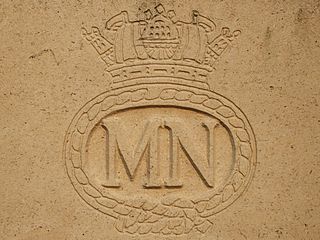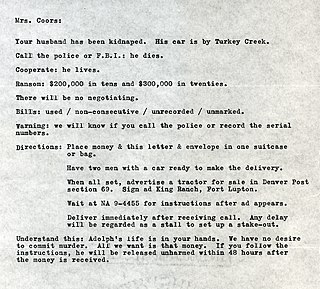
Maritime transport or more generally waterborne transport, is the transport of people (passengers) or goods (cargo) via waterways. Freight transport by sea has been widely used throughout recorded history. The advent of aviation has diminished the importance of sea travel for passengers, though it is still popular for short trips and pleasure cruises. Transport by water is cheaper than transport by air or ground, but significantly slower for longer distances. Maritime transport accounts for roughly 80% of international trade, according to UNCTAD in 2020.

The United States Merchant Marine is an organization composed of United States civilian mariners and U.S. civilian and federally owned merchant vessels. Both the civilian mariners and the merchant vessels are managed by a combination of the government and private sectors, and engage in commerce or transportation of goods and services in and out of the navigable waters of the United States. The Merchant Marine primarily transports domestic and international cargo and passengers during peacetime, and operate and maintain deep-sea merchant ships, tugboats, towboats, ferries, dredges, excursion vessels, charter boats and other waterborne craft on the oceans, the Great Lakes, rivers, canals, harbors, and other waterways. In times of war, the Merchant Marine can be an auxiliary to the United States Navy, and can be called upon to deliver military personnel and materiel for the military.

The Merchant Navy is the maritime register of the United Kingdom and comprises the seagoing commercial interests of UK-registered ships and their crews. Merchant Navy vessels fly the Red Ensign and are regulated by the Maritime and Coastguard Agency (MCA). King George V bestowed the title of "Merchant Navy" on the British merchant shipping fleets following their service in the First World War; a number of other nations have since adopted the title. Previously it had been known as the Mercantile Marine or Merchant Service, although the term "Merchant Navy" was already informally used from the 19th century.

Flag of convenience (FOC) is a business practice whereby a ship's owners register a merchant ship in a ship register of a country other than that of the ship's owners, and the ship flies the civil ensign of that country, called the flag state. The term is often used pejoratively, and although common, the practice is sometimes regarded as contentious.

Shanghaiing or crimping is the practice of kidnapping people to serve as sailors by coercive techniques such as trickery, intimidation, or violence. Those engaged in this form of kidnapping were known as crimps. The related term press gang refers specifically to impressment practices in the United Kingdom's Royal Navy.

The Merchant Marine Act of 1920 is a United States federal statute that provides for the promotion and maintenance of the American merchant marine. Among other purposes, the law regulates maritime commerce in U.S. waters and between U.S. ports. Section 27 of the Merchant Marine Act is known as the Jones Act and deals with cabotage. It requires that all goods transported by water between U.S. ports be carried on ships that have been constructed in the United States and that fly the U.S. flag, are owned by U.S. citizens, and are crewed by U.S. citizens and U.S. permanent residents. The act was introduced by Senator Wesley Jones. The law also defines certain seaman's rights.

Overseas Filipino Worker (OFW) is a term often used to refer to Filipino migrant workers, people with Filipino citizenship who reside in another country for a limited period of employment. The number of these workers was roughly 1.77 million between April and September 2020. Of these, female workers comprised a larger portion, making up 59.6 percent, or 1.06 million. However, this number declined to 405.62 thousand between 2019 and 2020.
The Tuvalu Overseas Seamen's Union (TOSU) is the only registered trade union in Tuvalu. It represents workers on foreign ships, and has a membership of 600.
The Seamen's Act, formally known as Act to Promote the Welfare of American Seamen in the Merchant Marine of the United States or Longshore and Harbor Workers' Compensation Act, was designed to improve the safety and security of United States seamen and eliminate shanghaiing.
Shannon J. Wall was a merchant seaman and an American labor leader. He was president of the National Maritime Union from 1973 to 1990. His father and mother ran a small dry cleaning company.
The International Seamen's Union (ISU) was an American maritime trade union which operated from 1892 until 1937. In its last few years, the union effectively split into the National Maritime Union and Seafarer's International Union.
The maritime history of the United States is a broad theme within the history of the United States. As an academic subject, it crosses the boundaries of standard disciplines, focusing on understanding the United States' relationship with the oceans, seas, and major waterways of the globe. The focus is on merchant shipping, and the financing and manning of the ships. A merchant marine owned at home is not essential to an extensive foreign commerce. In fact, it may be cheaper to hire other nations to handle the carrying trade than to participate in it directly. On the other hand, there are certain advantages, particularly during time of war, which may warrant an aggressive government encouragement to the maintenance of a merchant marine.
The United States merchant marine forces matured during the maritime history of the United States (1900–1999).

The Maritime Academy of Asia and the Pacific (MAAP) is a non-stock, non-profit maritime higher educational institution which is owned, developed and operated by the Associated Marine Officers' and Seamen's Union of the Philippines (AMOSUP). Its founding president, Capt. Gregorio S. Oca, alumnus of Philippine Nautical School headed the academy's board of governors, a group comprised by some of the organizations in the international maritime industry: the Filipino Association of Maritime Employers (FAME), the International Transport Workers’ Federation (ITF), the All Japan Seamen's Union, the Norwegian Seafarers’ Union (NSU), the International Maritime Employers Committee Limited (IMEC), the Danish Shipowners Association, the Norwegian Shipowners Association (NSA), Japanese Shipowners Association (JSA), and the International Mariners Management Association of Japan (IMMAJ). With their technical and financial support, the first MAAP campus opened in 1999.

The Maritime Labour Convention (MLC) is an International Labour Organization (ILO) convention, number 186, established in 2006 as the fourth pillar of international maritime law and embodies "all up-to-date standards of existing international maritime labour Conventions and Recommendations, as well as the fundamental principles to be found in other international labour Conventions". The other pillars are the SOLAS, STCW and MARPOL. The treaties applies to all ships entering the harbours of parties to the treaty (port states), as well as to all ships flying the flag of state party (flag states, as of 2021: over 91 per cent).

The Tuvalu Maritime Training Institute (TMTI) is on Amatuku motu, on Funafuti atoll in Tuvalu. TMTI provides training to approximately 120 marine cadets each year, to provide them with the basic skills necessary for employment as seafarers on merchant shipping. TMTI operates under the Tuvalu Maritime Training Institute Act 2000.

A sailor, seaman, mariner, or seafarer is a person who works aboard a watercraft as part of its crew, and may work in any one of a number of different fields that are related to the operation and maintenance of a ship.

The Government Shipping Office is an agency in the Government of Pakistan that registers and manages sailors in the Pakistan Merchant Navy. The Government Shipping Office was first established in 1923 under the Merchant Shipping Act. It was a subordinate office of the then-Ministry of Communications, now reorganised as the Ministry of Ports and Shipping, under the administrative control of Ports and Shipping Wing, Karachi.

Seaman Service Book (SSB) is a continuous record of a seaman’s service. This document certifies that the person holding is a seaman as per the International Convention on Standards of Training, Certification and Watch keeping for Seafarers (STCW), 1978, as amended from time to time. Seaman Book is one of the compulsory document for applying crew transit visas. The record of employment on board of a merchant ship (sea service) is recorded in a Seaman Service Book. Different countries issue to their seafarers the similar service book with different names i.e. Seaman Record Book, Seaman Discharge Book etc.

Crew management for ships, otherwise known as crewing, are the services rendered by specialised shipping companies. Crew management services are an essential part of maritime and ship management that includes the management of all the various activities handled by crew on-board vessels, as well as related shore-based administration. Major locations where crew management activities are carried out from include Limassol (Cyprus), Singapore, Hong Kong and Malta.
















